TrackMania
It's not going to set the world on fire, but it deserves to burn some of Europe at least.
Ramps. Everyone loves ramps. When you had a bike or a skateboard as a kid, most of the fun was going up and down ramps. When you got bored in GTA, ramps were there for you, fuelling endless hours of cunning stunts. The key to TrackMania's brilliance is clearly ramps - they make the difference between a bunch of matchbox cars zooming around in an entertaining physics demo and the most addictive precision-racer in ages. And racing isn't even the point! Although TrackMania is devilishly addictive to race around, and completing the developer's opening salvo of 24 sometimes fiendish tracks to gold medal standard will happily swallow an evening and leave you gasping for more, the gimmick that makes the headlines is the construction element, which gives you a point A and a point B, a few pieces of track and a target time.
Rewarding
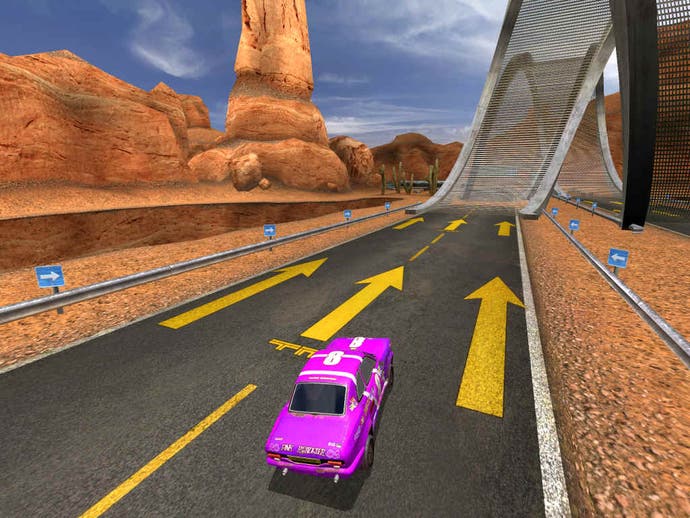
Building tracks from the ground up is tremendous fun. It's like the roller coaster building aspect of RollerCoaster Tycoon given centre-stage. You don't have to worry whether the hot dog stand is making any money, because there is no hot dog stand - instead, you just get to revel in the enormity and lunacy of your looping death-trap and then either scoot around it yourself or upload it (at a few Kb in size) to another TrackManiac. But to really take advantage of the "sand box" track creation mode, which gives you a blank slate to play with in one of the game's three terrain types (snow, desert and rally), you will need to earn Coppers, the game's currency, and buy up some of the more exotic track pieces from the in-game shop.
Perhaps it's a bit cynical to lock away most of the track editor's potential from the start, especially given the "Design it! Build it! Race it!" strap line, but actually the single-player mode serves as a healthy tutorial and a juicy carrot to lure you in. In truth you won't really care that you couldn't get at the best bits, because, if you're anything like me, by the time you get to the track editor you'll know more than enough about the game engine and vehicle behaviour to craft some brilliant courses. And certainly more than you would have diving in right from the start.
Not being able to unlock the more imaginative track parts also means that your path through the single-player "Race" mode will introduce you to them all in turn. Each new challenge is initially loaded into the editor view, whether editable or not, and I regularly spent a few seconds before I attempted each task for the first time just mapping the route in my head and gawping at the prospect of, for example, having to get up enough speed and find the right angle to leap diagonally through a loop-the-loop and land on a piece of elevated track on the other side. Experiencing it for the first time is the best, so I'm firmly in favour of the "withhold the goodies" policy as applied here.
American Beauty
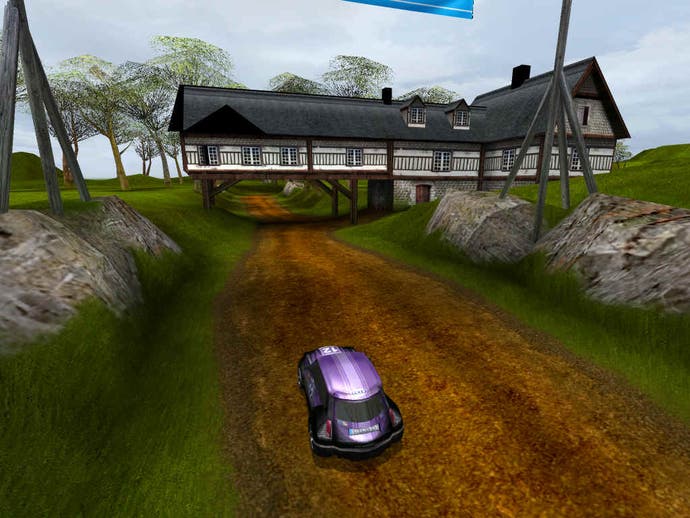
Part of that is of course down to the quality of the driving engine, which is deceptively simple and extremely absorbing. Controls are old-school cursor keys, with no manual gearshifts, handbrake turns or anything like that, and the feel of driving each of the game's three cars (one for each terrain type) is distinct enough to give it the feel of three separate racers. Each set of tracks commands a different kind of racing skill, even though the same physics underpin every task in the game, with a particular weight to each car and similar behaviour when landing awkwardly.
Our favourite mode of transportation after many, many hours of plugging away is probably the middle car - the "American Car", according to the manual - which is a fairly fast saloon with bouncy suspension that does better going round the game's tight bends on two wheels than it does sliding them. The tracks for this car, which calls the desert its home, vary from simple arrangements of basic jumps (usually preceded by speed boost pads) to more elaborate multi-tiered offerings (and even a few multi-storey car parks), and they are definitely the most enjoyable to race and complete - and the repetition and desire to earn golds on these courses probably earns the distinction of being "one more go" territory with greater ease than the rest of the package.
The other two vehicles do well enough at their own thing, but neither demands the same sloppy sort of Hollywood driving precision, flying off ramps at an angle to try and land facing in the right direction or gliding past cacti in the sand - it's the right balance. The Japanese pickup truck on the snow tracks, meanwhile, is almost too precise - you're told in the manual that as long as you don't hit anything you won't lose any speed, and this car has the best suspension and balance of any car we've ever seen, rounding extraordinarily tight bends at breakneck pace without spilling a wheel. Then there's the European Turbo2 rally car, which looks like a bit like a ladybird on wheels, slides viciously enough on the mud and supposedly tarmac surfaces, and has zero traction on the grass - harder, although arguably more satisfying than the Japanese pickup.
Exploitative, bless
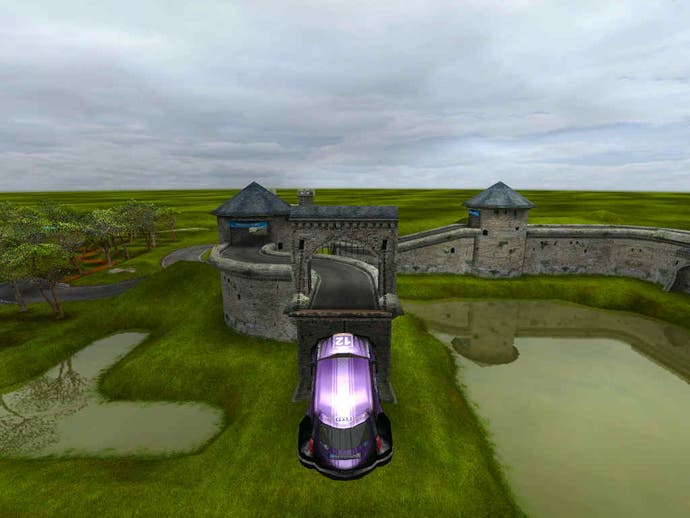
Then again, the developer has done a very good job of playing to each car's strengths, and it's clear that every task in the game was a labour of love for somebody. The pickup tracks, for example, do their best to exploit the absurd friction, allowing the player to drive around solid wooden courses literally sideways on tipping hairpins, while the rally courses have track pieces with arrangements of shimmy-able logs and rocks to spice up straights, not to mention the game's only water hazards - although the effect of these shiny and reflective ponds and lakes is diluted somewhat when you fall into one and discover you just fall through it and disappear as though it wasn't there. (Hey, what is it with awful water hazards in racing games? In WorldRacing you could drive out on the ocean and through bobbing yachts, and in Midtown and GTA water means instant death! Gamers Against Rubbish Water Hazards Unite!)
Another way to get to know the intricacies of the game is to experiment with the "Puzzle" track offerings, which offer the added bonus of gradually introducing you to the track editor. The idea of each "puzzle" is to design the most efficient course to try and earn the gold model - the catch is that tracks vary from seemingly complete and semi-complete to just start, checkpoints and finish. Sometimes the task won't give you the amount of pieces you think you need, sometimes you'll have to exploit the physics by taking advantage of cheeky shortcuts to get your time down, and sometimes you'll have to look at a track and try and work out how you can alter its existing layout with a couple of choice pieces - for example, being given a couple of small ramps (enough to jump about one square of track) and an inefficiently designed course which laps round a big outcropping of rocks and checkpoints and seems to backtrack on itself a couple of times.
Although these certainly require more thought than the basic racing tasks (which, I can confirm, are playable in several states of consciousness), it's a much more rewarding feeling to complete a tricky course to gold medal standard because you outwitted French developer Nadeo. As you trundle and fall from an elevated track to a section below, cutting out a hairpin and a couple of ramps, and scoot through the finish line well within the time limit, you'll find yourself thinking "I bet they never thought of that". And there's nothing better than feeling smarter than the French, right? Eh? Am I right guys?
Driving with friends
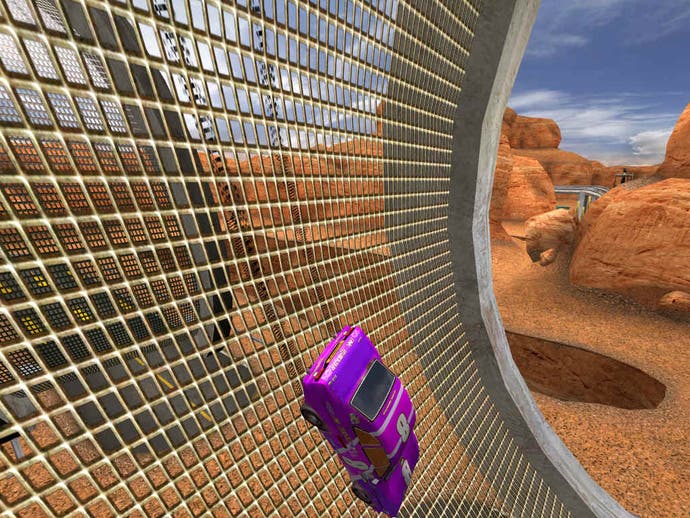
What should be one of the most glorious things about TrackMania is actually showing the French what you're made of via the game's online service. It's difficult to say whether the multiplayer element will do well online at the time of writing, because there aren't too many people playing it in this area with the game due out on November 28th. From my experience so far, the volume of cars and complicated behaviours of each means that some multiplayer games look a bit iffy, with opponents' cars clipping into scenery as the game seems to approximate their position a little, which flies in the face of the rest of the game - there are no clipping issues playing this alone, and the collision detection is exceptional.
That said though, the online service is otherwise extremely respectable. It doesn't demand your email address and sign you up to a stupid newsletter (yes, thank you Electronic bloody Arts) - it just works. You give it a username, password and a few details about your location (used to help filter servers more than anything, privacy fiends), and then you just click on the screen a few times to pick through servers. Game options are detailed for each, players can be added to a buddy list, and it's all so joyfully responsive - unlike the server navigation tools in most PC and indeed console titles.
And a bit of play over a LAN quickly demonstrates just why multiplayer is worth engaging in. You can race, alone or as a team, and time trial against one another, and there is definite scope to enjoy doing this for yonks, shading lap times with your flatmates or online buddy list competitors for hours. For me, TrackMania is quickly becoming the ultimate game to unwind with, as questing after the best lap times doesn't ask for too much brainpower and you can toggle the audio from the game's launcher and just sling on some music on the desktop. The prospect of competing with a well-organised community of like-minded racers fills me with excitement - as does the prospect of designing tracks for them and trying to master their tracks.
Shareware
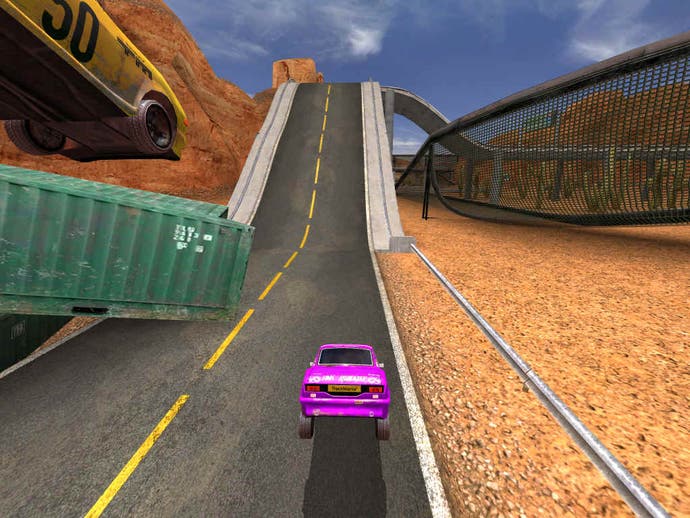
Which brings us full circle to the track editor, which is unquestionably a very versatile tool. It's kind of like the Build engine editor would have been back in the day if they had ever given it a decent front end. What you get is a grid, a number of pieces to choose from, the option to raise, lower and rotate them, options to do the same for the camera, and that's about it. With the handy keyboard shortcuts on the back page of the manual, you can actually learn to build tracks just using your keyboard, and it's perfectly possible to emulate the awe-inspiring and precisely crafted tracks from Nadeo's own designers after little more than an hour's work. The fact that each track is only a few Kilobytes in size (one I made earlier is about nine of the not even modem-chafing kilo-blighters) means we can probably look forward to community-made packs and, according to the developer, we can expect more from them to boot. Yep, TrackMania truly is the perfect PC game for Internet connected gamers. It's the perfect shareware title.
Oops. Hang on. But... no, you're right, this isn't a shareware game. It has a very generous shareware-like demo, which consists of ten puzzle and ten racing tracks and takes hours to truly get the most from and it's got the sort of graphical engine we usually associate with lower-end titles (some nice, tech demo-style vistas, lush and faintly cartoony texturing, massive draw distances and a rather generic overall design), but it comes in a DVD case and costs £29.99. Compounding the issue of whether it's "worth it", it's worth noting that the full game has about two and a half times the content of the free demo, although when it comes to user creations the sky's the limit.
When I took a look at the preview version of the game a few weeks ago (an early version of what then became the demo), I commented that it was comparable in terms of design and appeal to shareware classic Elasto Mania/Action Super Cross - evoking a sort of "fifteen-quid-for-the-rest-of-the-tracks" feeling, and I stand by that having taken on the finished game - but nevertheless the game does offer a lot of highly engaging content off the shelf, it gives you the chance to design even more elaborate tracks and has been built from the ground up to facilitate easy trading of ideas with fellow gamers. It may feel like a cheaper kind of game, but you'll still spend a huge amount of time getting the most out of it, and it's far more entertaining and polished than most of the third-person action rubbish we end up reviewing around here - oh how nice it is not to be complaining about a camera at this point in a review.
Worth keeping Track
In fact, the problem is that TrackMania exposes the simple fact that modern racing games are often pretentious, overblown affairs, and they simply can't match this for sheer fun. It almost feels awkward to play something this understated, but once you get over that you realise that all you need to have fun is a few squares of track snapped together creatively - and that you don't need in-game radio stations, real-time reflections or modern cityscapes to make your case. Nadeo just lets the gameplay do the talking, and it certainly talks to me. In the end, it's a package worth buying on its own - as long as you can stand the lack of licensing, narrative, voice acting or motion-capture, and I feel sure you can - and if you're reading this in 12 months' time and www.trackmaniagame.com is still alive and buzzing, then you can add one to the number below.

